8 Best Crystals For Plants And How To Use Them?
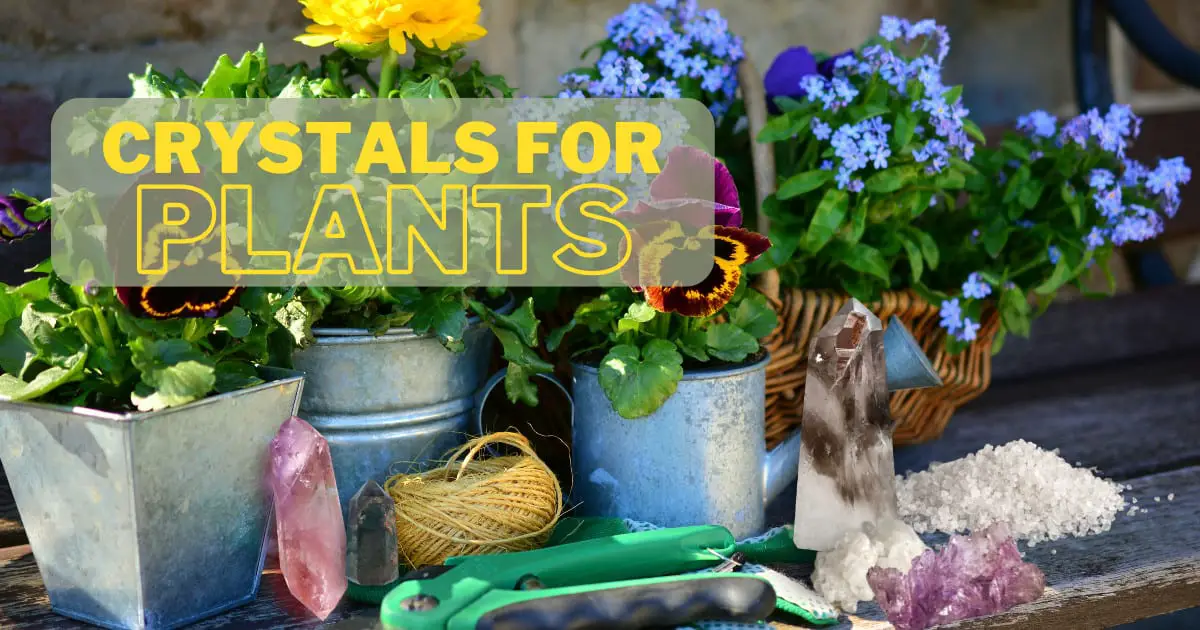
When you love to plant but simply lack a green thumb, it might be difficult and frustrating. Crystals for plants can be beneficial for both plants and gardeners. Gardeners who struggle to keep their plants alive will do virtually everything to help them. You can either try the less messy approach of strengthening plant energy by utilizing healing crystals for plants in the garden, or you can blend up odd and unpleasant concoctions to feed your sick plants.
Suggested Reading: Garden Quartz Meaning: Healing Properties, Benefits and Uses
It’s not simply a New Age trend to use precious stones and other crystals for communicating with plants for their healing properties. The healing properties of gemstones have been used by Native American shamans and many other practitioners for thousands of years. It was thought that various stones had unique curative qualities for various illnesses. These energies were employed to help heal people, animals, and plants.
Holistic healers still frequently use stones to facilitate healing today. The four elements (earth, air, fire, and water) are also represented by various stones, providing harmony and balance to the garden. When creating a Zen or meditation garden, it’s crucial to represent the elements.
Even if you do not think that gemstones have healing properties, using crystals in your gardening can give your beds and containers an aesthetic flair. Gemstones come in a wide range of hues and include distinctive textures like prickly clusters or perfectly smooth surfaces. Bird baths, fountains, succulent planter gardening, and fairy gardens can all incorporate little jewels. Large precious stones can be used to mark out trails or beds or positioned all around the garden as statues, gazing balls, or other garden décor.
In the same way, as they do with gazing balls, butterflies will use the shiny, shiny surface to effectively heat up themselves and evaporate dew from their wings. Antique crystal chandeliers or soft furnishings can be suspended from tree branches, pergolas, overhangs, etc. where the sun can shine on them and create dancing light patterns all over the garden. Crystals that are missing can be substituted with various unusual gemstones.
Suggested Reading: Buddstone Meaning: Healing Properties, Benefits and Uses
Table of Contents
Best Crystals For Plants
1. Clear Quartz
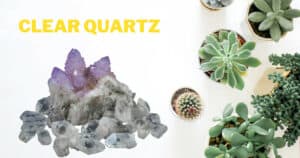
The most popular crystals used in wellness are clear quartz crystals. The high-energy vibrations of this stone are prized, and it also increases energy and emotions. Clear quartz encourages healing and growth in gardens. Quartz crystals come in small or huge chunks, can be found clustered or alone, and can be either rough or polished. Their transparent to slightly hazy white surface reflects light and occasionally creates rainbow reflections. Quartz is said to aid tomato plants in fending against pests and diseases like blight.
If you want to know more about the benefits of Clear Quartz crystals, click here.
2. Moss Agate
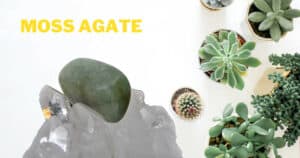
Moss agate, also referred to as the gardener’s stone is lovely whether polished or not. It has a light green tint. Moss agate provides grounding qualities and encourages a relationship with the soil. Additionally, it improves harmony and fosters the garden’s health and vitality. Moss agate can be found in chunks ranging in size from very large to very small. Petite and refined moss agate chips or pieces work beautifully as crystals for growing plants and accents in fairy gardens or gardens with cacti and succulents.
Read here to know the difference between Garden Quartz and Moss Agate.
3. Rhyolite
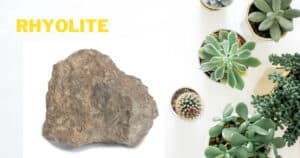
Rhyolite is a vivid crystal for dying plants that features splotches and streaks of orange, yellow, green, grey, and other colors. Rhyolite can be found in a variety of forms depending on the location. Rhyolite brings bravery, tenacity, and equilibrium energies to the garden. It is commonly among the best crystals for indoor plants.
4. Citrine
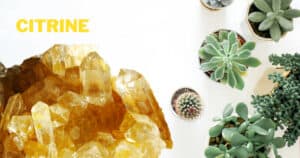
Citrine, which comes in hues of yellow, gold, and orange, represents the sun’s curative powers. Citrine, which is available in clusters, big or little single pieces, or chips, gives beds or containers a cheerful yellow touch. Out of the various benefits of Citrine, it encourages joy while removing poisons and negativity and proves as the best crystal for growing plants.
5. Malachite
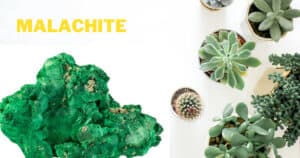
Malachite, another green stone, is symbolic of fertility and abundance. We naturally want our gardens to be productive and plentiful. Malachite also encourages metamorphosis and new growth. Malachite features veins that are various, deep colors of green, similar to green aventurine. Unique garden accents can be created with large raw pieces. Malachite crystals have outstanding benefits and you can know about them here.
6. Moonstone
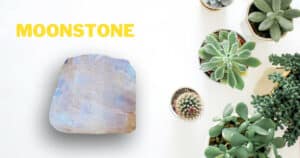
Moonstone is transparent to a hazy white gemstone, similar to clear quartz. Moonstone is related to the moon, as suggested by its name. They are wonderful complements to lunar gardens, particularly when highlighted by outdoor lighting. The moonstone encourages health and fertility. Additionally, it adds a tranquil and relaxing atmosphere. other than benefiting plants, Moonstone also has numerous other astonishing benefits, and to know them click here.
7. Green Aventurine
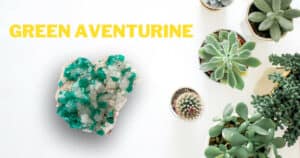
Dark green to light green can be found in green aventurine. The hue is bright in all of its variations. Smaller stones can differ widely in color and create an attractive fill for container plants, bird or butterfly baths, and fountains while larger stones may exhibit mottling of various green tones. It also offers a less expensive substitute for jade for bonsai or Zen gardens. Stress is reduced and negativity is absorbed by green aventurine. It can help with new plantings and lessen the impact of transplant shock. It is also regarded as a stone of healing.
8. Tiger’s Eye
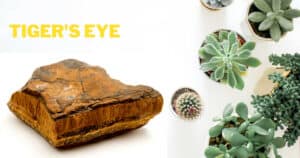
The streaking pattern of the tiger’s eye typically comes in shades of brown, grey with gold veins, and white. In high light, it can have a reflective, holographic aspect. Tiger’s eye fosters healthy root development, harmony, and garden success.
Water Gel Crystals For Plants
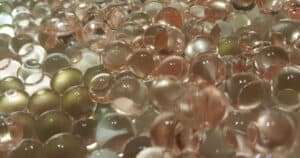
The terms potassium polyacrylate and super absorbent polymer are also used to describe water retaining gel. It is a brand-new type of polymer with extraordinary water absorption capabilities. A gram of water-retaining gel can absorb 300–1000 grams of water.
Let’s now discuss the benefits for plants. When it rains or is watered, the water-holding polymer can take up water and transform it into water gel. Additionally, water crystals for pot plants can return water to a plant’s root when the dry season arrives. Therefore, you might think of it as a “Mini-reservoir.”
The following are the key benefits for plants:
- Improve seed emergence and germination to offer plants a head start and a healthy start.
- Increase agricultural and fruit productivity while saving water through irrigation.
- Potassium, phosphorus, and nitrogen are present, and it releases fertilizer effectiveness gradually.
How to Use Crystals for Plants?
The first step is getting the crystals, and then you can start gardening and start using them in your practice.
There are various ways to use crystals for potted plants in gardening. While some crystals must be placed in a certain way, others can be useful everywhere.
A Sacred Garden
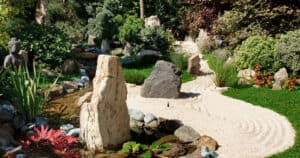
Most of us use an area for a variety of purposes, which might be detrimental to our mental health. In an ideal world, we would all have appropriate areas to eat, sleep, work, play, and unwind, but for the majority of us, it simply isn’t possible.
Create a holy space where you can access the empowering and uplifting energies that crystals and plants provide. All you need to use crystals for gardening is a peaceful, natural area where you can pray or meditate.
While relaxing in your garden or close to your plants, hold your crystals. Program your stones with an affirmative prayer to make sure they are prepared to work for your garden.
What are Garden Quartz Properties? Read here.
Crystal Elixir
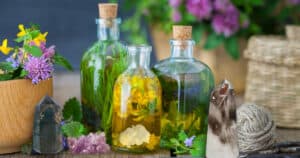
Simple recipes that call for a pitcher, crystals, and water are known as crystal elixirs. It is advised to use the indirect method while creating a crystal elixir, especially if you are unsure of the crystals’ potential toxicity.
Fill an empty jar with clean stones, then submerge the jar in a pitcher of water. To charge and increase the energies of the crystals, let the water remain either within the moonlight or the sunlight.
Put this elixir into a new glass or watering can after around 24 hours, then use it to water your plants.
Suggested Reading: Buddstone Meaning: Healing Properties, Benefits and Uses
Conclusion
You can use any stone that you have a unique connection to or simply like, even though green stones are most frequently used to symbolize the earth and garden healing. Sick plants benefit from the healing energies added by sodalite, amethyst, rose quartz, and tourmaline. Jaspers have a reputation for promoting fresh growth. For tomato plants, onyx and obsidian are suggested materials. It has been said that dark stones like onyx and obsidian confuse and deter pests. Gemstones with gardening can help your beds and containers stand, no matter what stones you choose.
Suggested Reading: Onyx Meaning, Healing Properties, Benefits and Uses



